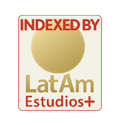interface for The Collective Memory
artistic Practices of The Eighties in The Southern Cone
DOI:
https://doi.org/10.24215/24691488e117Keywords:
interface, sensorium, artistic practicesAbstract
This study addresses the reproduction technologies incidence in the artistic practices of the first post-dictatorial democratic period in the Southern Cone. From investigating the continuity of a sensorium, that would have been taken up from the experiences of the sixties —between experimentalism and the political avant-garde—, and that was reformulated in the eighties, from a new way between subjectivity , aesthetics, politics and memory, a deviational aspect of the technique is registered. This article analyzes the installation Sal-si-puedes (1983) by Nelbia Romero (Uruguay) from intermediality (Chiel Kattenbelt, 2008) and as an interface for the collective memory construction.Downloads
References
Abella, J. (2014). Salsipuedes es la primera acción de terrorismo de estado en Uruguay [Radio]. Mañana de Radio. https://www.radio36.com.uy/entrevistas/2014/04/09/abella.html
Agamben, G. (2019). Creación y Anarquía. Adriana Hidalgo.
Alonso, R. (2006). Arte, ciencia y tecnología. Vínculos y desarrollo en Argentina. Cuadernos del Centro de Estudios en Diseño y Comunicación, (20), 21-34. https://doi.org/10.18682/cdc.vi20
Álvarez Cozzi, F. y Aguerre, E. (2007). La condición del video. 25 años de videoarte en el Uruguay [Catálogo de exhibición]. Centro Cultural España.
Barbero, M. (1991). De los medios a las mediaciones. Gustavo Gili.
Buck Morss, S. (2015). Estética y Anestésica, Una reconsideración del ensayo sobre la obra de arte. En T. Barros Vera (Org.), Estética de la imagen (pp. 159-205). La Marca editora.
De La Puente, M. (2013). Teatro, resistencia y efervescencia cultural en la Argentina de los años ochenta. Argus-a Artes y Humanidades, 2(8), 1-15. https://argus-a.org/archivos-dinamicas/teatro-resistencia-y-efervescencia-cultural.pdf
Dubatti, J. (2002). El nuevo teatro de Buenos Aires en la postdictadura (1983-2001). En J. Dubatti (Org.), Micropoética: Vol. I (pp. 3-80). Instituto Movilizador de Fondos Cooperativos del Centro Cultural de la Cooperación.
Fiuca Tadeo, B. y Balas, M. (2016). CEMA: Archivo, video y restauración democrática. Udelar Icau.
Giunta, A. (2021). Feminismo y Arte Latinoamericano. Siglo XXI.
Huyssen, A. (2002). Después de la gran división. Modernismo, cultura de masas, postmodernismo. Adriana Hidalgo.
Kattenbelt, C. (2008). Intermediality in Theatre and Performance: Definitions, Perceptions and Medial Relationships [Intermedialidad en el teatro y la performance: Definiciones, percepciones y relaciones mediales]. Cultura, Lenguaje y Representación, Revista de Estudios Culturales de la Universidad de Jaume, (6), 19-29.
Larnaudie, O. (2005). Nelbia Romero. Montevideo, Banco Central del Uruguay.
Longoni, A. (2010). Tres coyunturas del activismo artístico. Voces en el Fénix, (1). https://vocesenelfenix.economicas.uba.ar/tres-coyunturas-del-activismo-artistico/
Longoni, A. y Bruzzone, G. (2008). El Siluetazo. Adriana Hidalgo.
López Ruiz, A. (2019). El cine experimental desde Uruguay hacia el Sur de América Latina [plataforma]. En G. Zabaleta (coord.), Intersticios. https://cce.org.uy/evento/intersticios-cuerpos-politicos-estrategias-conceptualistas-y-experimentalismoscinematograficos/
Pérez, D. (2019). ¿Quién escupió el asado? Alter.
Pérez Buchelli, E. (2014). Octaedro, Los Otros y Axioma: relecturas del arte conceptual en el Uruguay durante la dictadura (1973-1985). Yaugurú.
Pérez Buchelli, E. (2019a). Performance, arte y cultura juvenil en los ochenta en Montevideo. En X. Ponce (Org.), Conversaciones, anotaciones y dramaturgia en las artes vivas: España y Uruguay (pp. 249-276). Estuario Editora.
Pérez Buchelli, E. (2019b). Cuerpos políticos. Mujeres artistas uruguayas de los sesenta [plataforma]. En G. Zabaleta (coord.), Intersticios. https://cce.org.uy/evento/intersticios-cuerpos-politicos-estrategias-conceptualistas-y-experimentalismoscinematograficos/
Puchet, M. (2019). Estrategias conceptualistas. Octaedro, Los Otros y Axioma. [plataforma]. En G. Zabaleta (coord.), Intersticios. https://cce.org.uy/evento/intersticios-cuerpos-politicos-estrategias-conceptualistas-y-experimentalismos-cinematograficos/
Red Conceptualismos del Sur. (2013). Perder la forma humana. Una imagen sísmica de los años 80 en América Latina. Museo Nacional Centro de Arte Reina Sofía.
Richard, N. (2006). Los pliegues de lo local en el mapa de lo global, reticencia y resistencia. Signo y Pensamiento XXI, (49), 46-57.
Richard, N. (2009). Lo político en el arte, arte, política e instituciones. Revista emisférica, (62). http://hemisphericinstitute.org/hemi/es/e-misferica-62/richard
Romero, N. (1983). Sal-si-puedes [Instalación]. Galería del Notariado, Montevideo.
Stiegler, B. (2004). La técnica y el tiempo, Vol. I. Hiru.
Vindel, J. (2014). La vida por asalto, arte, política e historia en Argentina entre 1965 y 2001. Brumaria.
Downloads
Published
How to Cite
Issue
Section
License

This work is licensed under a Creative Commons Attribution-NonCommercial-ShareAlike 4.0 International License.
The acceptance of the manuscript by the magazine means the non-exclusive cession of the property rights of the authors in favour of the editor, who allows the reuse, after publication (post print), under a license Attribution-NonCommercial-NoDerivatives 4.0 International. According to these terms, the material can be copied and redistributed by any means or in any format as long as a) the author and original source of the publication are quoted (magazine and URL of the work), access to the license is provided and whether changes have been made is mentioned; and b) the material is not used for commercial purposes.
The cession of non-exclusive rights means that after the publication (post print) in Arte e Investigación the authors can publish their work in any language, means and format; in such cases it must be mentioned that the material was originally published in this magazine. Such cession also means the authorization of the authors for the work to be collected by SEDICI, the institutional archive of the National University of La Plata, and to be spread in the databases that the editorial team considers appropriate to increase the visibility of the publication and its authors.
Moreover, the magazine encourages the authors to deposit their productions in other institutional and thematic archives under the principle that offering the society the scientific and academic production without any restrictions contributes to a greater exchange of the global knowledge.

































